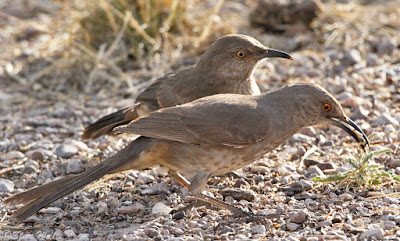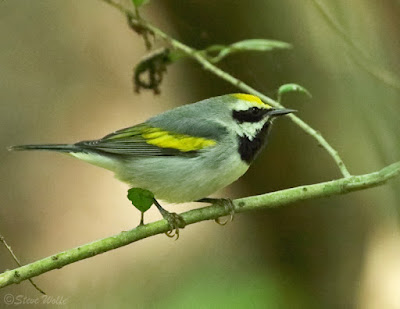The skies have been cloudless lately, and actually a long-time resident (and good friend) said that's the way skies usually are here except during the monsoon season, which starts in July. But the full moon has been making up for the lack of clouds, especially moonset over Cave Creek Canyon just after sunrise --
That's one of the desert willows on my property, in the left-hand corner with the blooming flowers. Here's a close-up of the moon just before it disappears behind the sunrise-lit walls of Cave Creek Canyon --
The Javelina Horde paid a visit to my back yard again --
I watch them from my back porch, which is elevated above the ground so I can see them from a safe vantage point. As long as you move slowly, they're fine; it's when you do a sudden movement that they get startled and, er, "rambunctious". As before, they just vacuum up the bird seed and drink and wallow in the water features. They're pests, but as long as they stay away from my fenced-in trees I'm trying to grow, they're tolerable. Not that I have any choice, as any kind of fence to keep them off my property would also keep out the critters that I want to use the water features, and are featured on my
Critter Cam.
The birds in my back yard have been plentiful and varied. The Pine Siskins have moved on -- thankfully, as they were chowing down all of my Nyger -- as have the White-crowned Sparrows. Now I'm getting Western Tanagers; here's a female --
A Verdin family; here's one of the adults feeding its young; it looks as big as its parent --
"Aren't you EVER going to leave?" --
Black-headed Grosbeak --
The Orioles are coming to the jelly saucer I've put out for them. Well, so are the House Finches, and even the Verdin is taking a bite or two of the jelly. I've had Scott's, Bullock's, and this male Hooded Oriole --
But my favorite temporary resident is this beautiful male Grosbeak. There's another one here, too, a young one with a splotchy blue pattern --
Taking care of a house comes with being a homeowner. I don't mind it; in fact I like the challenge of keeping everything in tip-top condition as much as possible. And that's more difficult to do when you don't have a Home Deport down the road (my hardware store of choice is B and D Lumber in Douglas, 55 miles away). And then you have to make sure the appliances are all in working order. As I have a water softening system, appliances which use water, such as the washer and dish washer, will last longer as there is less mineral buildup than if I didn't have them; there's high iron content if my well water. The pipes should last longer, too. And then there's the York heat pump, which supplies both heat and air conditioning to Faranuf. Here it is, on the north side of the house --
Most houses have wood-burning units to keep things warm; my house is all-electric, so I have to keep a close eye on the electricity bills. When the service guy for the heat pump came out here last December (and the charge just to get out here runs about $90) he found mold on a circuit board. How the heck did THAT get there? He took a photo of it with his cell phone and showed it to others at his business; they'd never seen it before, either. He didn't replace it at the time as it was still working, but when he came back this week to check it, this time he found out what caused the problem -- a leaky condenser that was on a shelf right above the moldy circuit board. Apparently it was slowly dripping water on it -- and now the mold had spread to a neighboring circuit board. He re-arranged things, moving the condenser so it wouldn't leak on anything, and tilted the shelf it was sitting on so any water would run off and not pool, which is what it had been doing. And he placed the circuit boards on a side wall so water wouldn't leak on them again. Alas, the heat pump was out of warranty, and I also decided to add a 2-year service plan as I didn't want any issues with the unit while I was traveling. The total cost: nearly $1,000. And I gave the guy money for lunch as he had to drive nearly 200 miles to get here. "What's the fastest way to get back on Interstate 10 from here?" "Foothills Road, which is right in front of my house. But it's about 20 miles of dirt road, then paved for about the last 5 miles to the interstate." Such is life out here. But I consider these to be minor inconveniences; living out here is still worth it...


























































